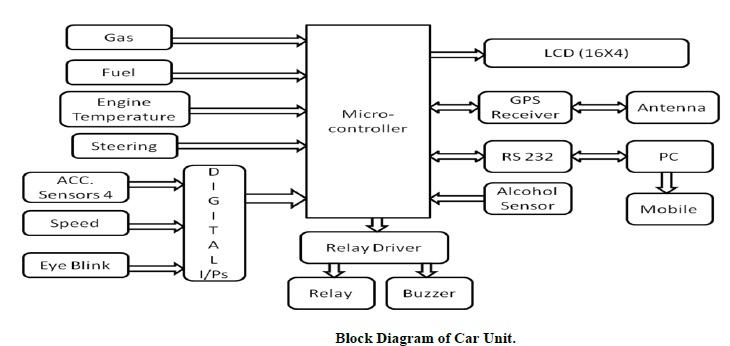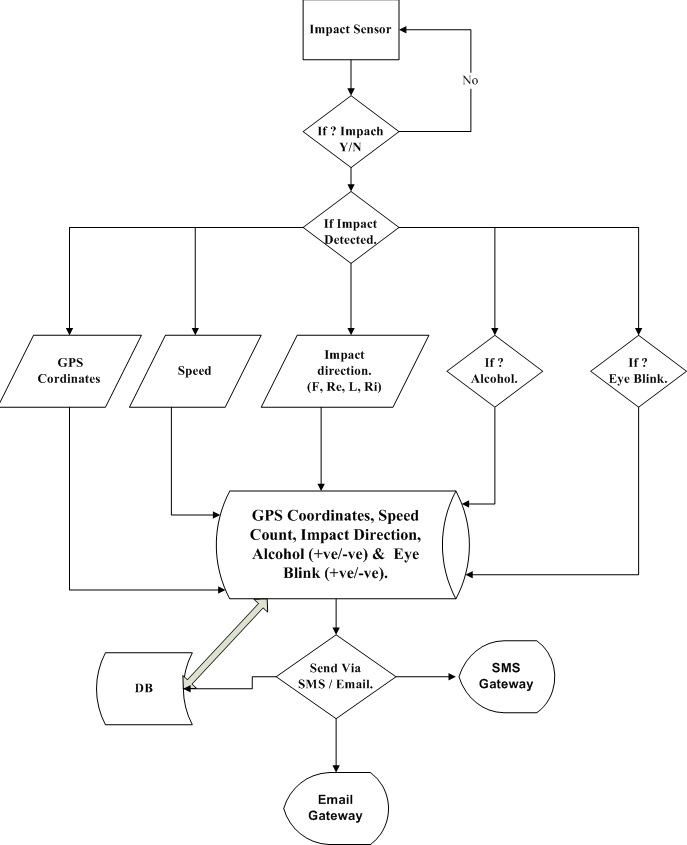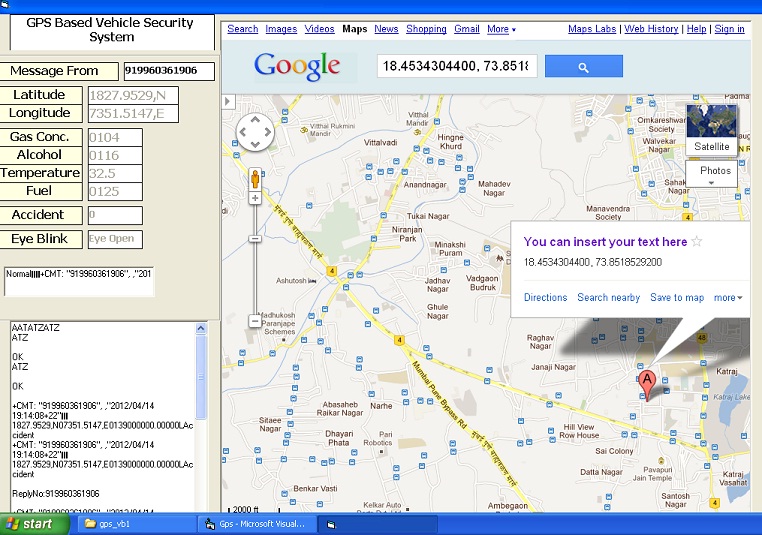





Published on Nov 30, 2023
This project is about making cars more intelligent and interactive which may notify or resist user under unacceptable conditions, they may provide critical information of real time situations to rescue or police or owner himself. Driver fatigue resulting from sleep deprivation or sleep disorders is an important factor in the increasing number of accidents on today's roads. In this paper, we describe a real-time online safety prototype that controls the vehicle speed under driver fatigue. The purpose of such a model is to advance a system to detect fatigue symptoms in drivers and control the speed of vehicle to avoid accidents. The main components of the system consist of number of real time sensors like gas, eye blink, alcohol, fuel, impact sensors and a software interface with GPS and Google Maps APIs for location.
Each year, car enthusiasts salivate at the prospect of seeing what bleeding-edge designs automakers will unveil on the car show circuit. Those same enthusiasts are often disappointed when the amazing concepts still haven't made it to the auto dealer's showroom floor several years later. But before any new car model can ever go on sale to the public, it must first undergo a battery of testing to make sure it'll be safe, reliable and reasonably in tune with the demands of the motoring public. The government demands some of this testing, while other major components of it are devised by the car companies themselves in an effort to ensure they meet specific standards for performance, fuel economy, comfort and other measures, but those which don’t are axed. Driving while either intoxicated or drunk is dangerous and drivers with high blood alcohol content or concentration (BAC) are at greatly increased risk of car accidents, highway injuries and vehicular deaths. Every single injury and death caused by drunk driving is totally preventable. At present drunken drivers have increased enormously and so is the deaths due to drunken drivers. The mail reason for driving drunk is that the police are not able to check each and every car and even if they catch any one the police can be easily bribed. So there is a need for an effective system to check drunken drivers.
Intelligent systems are in used with every aspect of systems, CARs are the critical systems which are real time and lives are involved. This System not only deals with component monitoring, does even more than that like Passenger activity monitoring, Behavior analysis, System behavior, Notification & co-ordinate. Eye blink Sensor & Alcohol detection are the vital and of great importance from the perspective of passenger safety and traffic safety. Impact detection and notification is also one of the life saving and critical information provider system.
Although the first research efforts on developing intelligent vehicles were seen in Japan in the 70’s, significant research activities were triggered in Europe in the late 80s and early 90s. MITI, Nissan and Fujitsu pioneered the research in this area by joining forces in the project “Personal Vehicle System” [3]. In 1996, the Advanced Cruise-Assist Highway System Research Association (AHSRA) was established among automobile industries and a large number of research centers [2]. In the US, great deals of initiatives have been launched to address this problem. In 1995, the US government established the National Automated Highway System Consortium (NAHSC) [4], and launched the Intelligent Vehicle Initiative (IVI) in 1997. Several promising prototype vehicles/systems have been investigated and demonstrated within the last 15 years
ABS works with your regular braking system by automatically pumping them. In vehicles not equipped with ABS, the driver has to manually pump the brakes to prevent wheel lockup. In vehicles equipped with ABS, your foot should remain firmly planted on the brake pedal, while ABS pumps the brakes for you so you can concentrate on steering to safety.
Electronic brake-force distribution (EBD or EBFD), Electronic brake-force limitation (EBL) is an automobile brake technology that automatically varies the amount of force applied to each of a vehicle's brakes, based on road conditions, speed, loading, etc. always coupled with anti-lock braking systems.
An airbag is a vehicle safety device. It is an occupant restraint consisting of a flexible envelope designed to inflate rapidly during an automobile collision, to prevent occupants from striking interior objects such as the steering wheel or a window, the sensors may deploy one or more airbags in an impact zone at variable rates based on the type and severity of impact; the airbag is designed to only inflate in moderate to severe frontal crashes.
An immobilizer is an electronic device fitted to an automobile which prevents the engine from running unless the correct key (or other token) is present. This prevents the car from being "hot wired" after entry has been achieved.
Parking sensors are proximitysensors for road vehicles which can alert the driver to unseen obstacles during parking man oeuvres. Parking sensors generally fall into two categories.
i) Electromagnetic parking sensors
ii) Ultrasonic parking sensors
Cruise control (sometimes known as speed control or auto cruise) is a system that automatically controls the speed of a motor vehicle. The system takes over the throttle of the car to maintain a steady speed as set by the driver.
N.B: None of this above detects Driver or Passenger misbehavior.


• System which is more efficient, reliable & effective.
• To overcome the limitations of existing systems.
• To develop a smart CAR to control and notify it Users.
• There are very less number of systems implemented on human behaviour detection in or with cars.
• To develop a system with all the useful utilities, this will help OWNERs, Police, Rescue Squad and other authorities do their work more efficient and effective.
1. Intelligent systems are in used with every aspect of systems, CARs are the critical systems which are real time and lives are involved.
2. This System not only deals with component monitoring, does even more than that.
a. Passenger activity monitoring
b. Behavior analysis.
c. System behavior.
d. Notification & co-ordinate.
3. Eye blink Sensor & Alcohol detection are the vital and of great importance from the perspective of passenger safety and traffic safety.
4. Impact detection and notification is also one of the life saving and critical information provider system.
The GPS smart receiver features the 16 channels, Ultra low power GPS architecture. This complete enabled GPS receiver provides high position, velocity and time accuracy performances as well as high sensitivity and tracking capabilities. Thanks to the ultra low power CMOS technology, the GPS receiver is ideal for many portable applications such as PDA, Tablet PC, smart phone etc.
We continuously scan for various parameters of car, such as fuel, engine temperature, speed, steering position, eye blink and alcohol sensors, as soon as impact id detected more impact related sensors comes in pictures. The μC stores all this data in the internal memory. If the driver is found to have alcohol in the breath, it warns and then turns the ignition off (if μC is set with threshold values is set; also applicable to other sensors like fuel, gas, speed, steering, eye blink, engine temperature, etc.) And hence possibility of an accident is avoided. Also we have designed an eye blink sensor which continuously monitors the number of times the eye blinks, if the eye blinks count decreases that means the driver is sleepy, in that case a buzzer is operated. If accident happened by using impact sensors we are able to found out on which side the impact occurred.
After collecting all information which is stored in internal memory, μC send this data to base or surveillance unit via SMS using GSM modem. On the base side we receive the data such as engine temperature, gas, fuel, speed, eye blink status, alcohol level, impact etc. and also the GPS co-ordinates on the online Google maps. The PC unit has the online VB software which graphically shows all the data to the analyst so that the reasons of crash or accident can be understood better.

It is due to the driver’s fatigue, traffic accidents keep with a yearly increasing of a high rate. This paper shows the new fatigue detection algorithms & techniques using eye blink, alcohol, impact, gas, etc. sensors. In this technique the fatigue will be detected immediately and regular traps the events driver and third party. Through research presented in this paper, we propose an intelligent car system for accident prevention and making the world a much better and safe place to live.
[1] Zutao Zhang, Jiashu Zhang, “A Novel Vehicle Safety Model: Vehicle speed Controller under Driver Fatigue”, “IJCSNS International Journal of Computer Science and Network Security”, VOL.9 No.1, January 2009
[2] M. Bertozzi, A. Broggi, M. Cellario, A. Fascioli, P. Lombardi, and M.Porta, “Artifical vision in road vehicles,” Proceedings of the IEEE, vol. 90,no. 7, pp. 1258–1271, 2002.
[3] S. Tsugawa and Sadayuki, “Vision-based vehicle on japan: Machine vision systems and driving control systems,” IEEE Trans. on Ind. El.???, vol. 41, no. 4, pp. 398–405, 1994.
[4] Vehicle-highway automation activities in the United States. U.S. Dept of Transportation, 1997.
[5] C. Thorpe, J.D. Carlson, D. Duggins, J. Gowdy, R. MacLachlan, C. Mertz, A. Suppe, and C. Wan, “Safe robot driving in cluttered environments,” 11th International Symposium of Robotics Research, 2003.